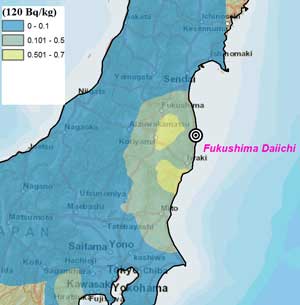ArcUser
Fall 2012 Edition
Modeling Contamination Using Empirical Bayesian Kriging
By Konstantin Krivoruchko, Senior Research Associate, Software Development Team, Esri
Editor's note: This article discusses the analysis of contamination data collected for two nuclear accidents. This analysis was performed using the empirical Bayesian kriging (EBK) tool, one of the tools available in the ArcGIS Geostatistical Analyst extension for ArcGIS 10.1 for Desktop. EBK is a particularly robust method of data interpolation because it accounts for the error introduced by estimating the semivariogram model. (For a comprehensive discussion of this tool, see "Empirical Bayesian Kriging Implemented in ArcGIS Geostatistical Analyst.")
The author looks at data measuring the dispersion of radionuclides following the 1986 fire and explosion at the Chernobyl nuclear power plant in the Ukrainian Soviet Socialist Republic (now the Ukraine) and the earthquake triggered accident at the Fukushima Daiichi Nuclear Power Station in Japan in 2011.
While the radionuclides dispersed after a nuclear accident tend to remain near the soil surface due to slow vertical migration in most soils, natural processes and human activity can redistribute them throughout the environment, where they can present both real and perceived threats to health. The best approach for managing health risks to a population from radioactive contamination is through the measurement of accumulated radioactivity in individuals. The link between population exposure to radionuclides and the increase (or decrease) of a particular disease is lost when individual accumulated doses are unknown. In areas where data on population exposure is not available, data on food contamination can be used to estimate radioactivity dose accumulated in the human body. Direct use of soil contaminants to assess public health impacts may not be appropriate, but this data does provide a useful measure for estimating total and average contamination of areas and can be obtained using the Conditional Simulation geoprocessing tool in the Geostatistical Analyst extension.
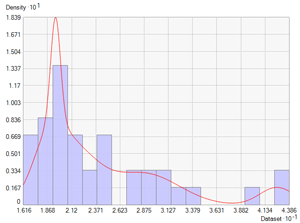
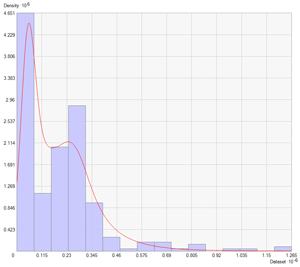
Figure 1. The distribution of accumulated 137Cs in children cannot be reconstructed from the distribution of 137Cs soil contamination (B). (A) shows the 137Cs accumulation in children whereas (B) shows soil contamination.
Using regularly collected data on air, soil, food, and human body contamination, along with the data interpolation techniques available through use of the tools in the Geostatistical Analyst extension, provides effective radioecological data management, visualization, and spatial data analysis.
Estimating Accumulated Radiocesium at Chernobyl
Ten years of radioecological and epidemiological research in Belarus after the Chernobyl accident found that accurately predicting the accumulated dose in people based on airborne and soil radioactivity measurements is extremely difficult. Calculations based solely on radiocesium (137Cs) measurements greatly underestimated the actual accumulated doses. [The author was involved in radioecological and epidemiological research at the Nuclear Power Institute and the Sakharov Institute of Radioecology in Minsk. He was also a member of the governmental radioecological commission and worked extensively with Byelorussian and Swiss oncologists.]
Among the problems with estimating accumulated doses is the varied or heterogeneous radiation field that exists in the air and soil, which is further compounded by the large variation in the transfer of 137Cs from the soil to cultivated plants and farm animals. In addition, there is a nonlinear relationship between the accumulated dose in the human body and 137Cs measured in air, soil, and food. Figure 1a shows the distribution of accumulated 137Cs in children from the northern Gomel region in Belarus. This distribution clearly differs from the distribution of 137Cs in the soil in this area (Figure 1b). In relating exposure to health outcomes, incidents in an area should only be compared with the 137Cs distribution found in people (Figure 1a).
It was documented in Chernobyl: Consequences of the Catastrophe for People and the Environment by A.V. Yablokov, A.B. Nesterenko, and A.V Nesterenko that 5 to 15 percent of these children (represented by the right tail of the distribution in figure 1a) who were living in the same area and were assumed to have the same diet would accumulate 3 to 5 times more activity than the average for the group. Furthermore, the average accumulated activity in children can be 3 to 5 times higher than that in adults on the same diet.
Figure 2 shows the result of interpolation of the average accumulated 137Cs activity for all children (A) and children prone to radiosensitivity (B) in Gomel province in Belarus 15 years after the Chernobyl accident. Even when the average of all children—rather than just sensitive children—was used, the analysis produced areas that indicate dangerous exposure and, therefore, potential health risk.
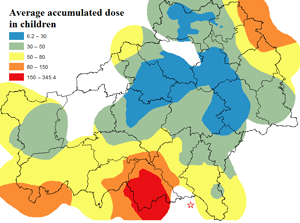
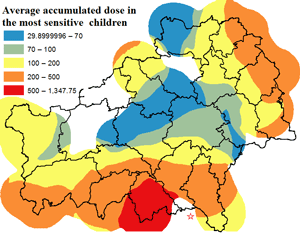
Figure 2. The average accumulated 137Cs activity in children in Gomel province, Belarus in 2001(measured in bq/kg). (A) shows accumlations for all children while (B) shows accumulations for radiosensitive children.
Estimating Food and Milk Contamination in Japan
Although information about individual doses in Japan is not publicly available, the Fukushima Prefectural government, Japan's Ministry of Education, Culture, Sports, Science and Technology (MEXT); and other Japanese government and scientific organizations have published some radiation data in PDF. This data was preprocessed by Esri Japan Corporation for use in ArcGIS.
Radioactive iodine (131I), with a half-life of eight days, is one of the most dangerous initially deposited radionuclides. If it is inhaled or ingested, it is rapidly absorbed into the systemic circulation from the lungs and the gastrointestinal system.
Figures 3a and 3b show 131I contamination of vegetables and milk in becquerels per kilogram (bq/kg). [A becquerel is a unit of radioactivity.] The samples were geocoded to the small administrative regions where food samples were tested for radionuclide contamination. Average 131I values by administrative district, collected over several months, were interpolated using EBK. Although the number of measurements of 131I food contamination is sufficiently large—3,350 vegetable samples collected in 136 administrative regions—the measurements were unevenly distributed and additional observations could affect the locations of hot spots.
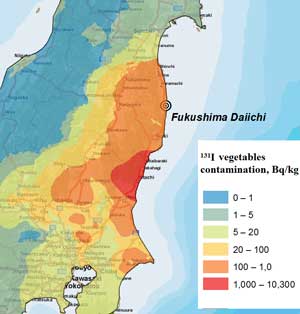
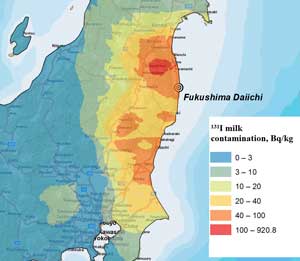
Figure 3. EBK predictions in bq/kg for 131I in vegetables (A) and in milk (B)
Large 131I values were observed in vegetables in the area between the Fukushima Daiichi Nuclear Power Station and Tokyo. One possible explanation for this hot spot is the wet deposition of 131I several days after the accident. Differences between the locations of hot spots of 131I contamination for vegetables and milk could also be attributed to differences in production. Vegetable cultivation is widely dispersed whereas milk production is clustered.
Prediction and prediction standard error surfaces for 137Cs concentration in bq/kg in vegetables were modeled using EBK (Figure 4a) to answer the question of which areas should be considered dangerous. According to regulations adopted in the Ukraine in 2006, the upper permissible threshold is 40 bq/kg. Therefore, people living in the areas shown in yellow, brown, and red would potentially be at risk from high levels of radiation. However, it should be noted that data variability is large and, therefore, the prediction uncertainty is also large. Further data sampling is required to reduce the prediction uncertainty of the areas in red in Figure 4b.
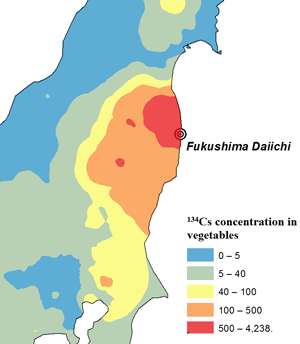
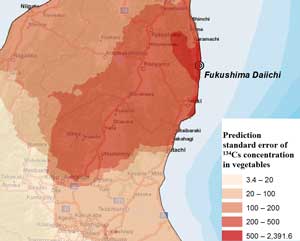
Figure 4. Predicted 134Cs in bq/kg in vegetables (A) and the associated prediction standard errors (B)
137Cs contamination of vegetables can be modeled in the same way. Figure 5a shows the probability that the threshold of 0.024 bq/kg is exceeded. The level of 0.024 bq/kg in vegetables was observed in Denmark in 1984, two years before the Chernobyl accident. This level of contamination was due to nuclear tests in the atmosphere during the previous three decades.
In the Ukraine, the upper permissible level of 40 bq/kg is acceptable. Figure 5b shows the probabilities that 137Cs concentration of 40 bq/kg in vegetables was exceeded. Figure 5c shows the probabilities that the threshold of 120 bq/kg (the upper permissible level accepted in Russia) was exceeded.
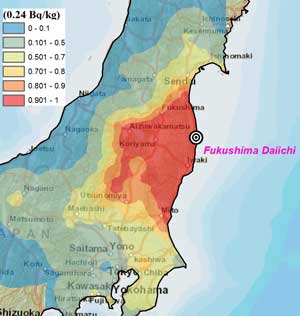
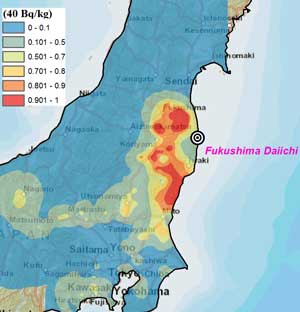
Figure 5. Probability that 137Cs in vegetables exceeds 0.024 bq/kg (A), 40 bq/kg (B), and 120 bq/kg (C).
Conclusion
Radioecological problems are complex, and it is dangerous to base decisions on oversimplified "average" models, in particular in relation to public health outcomes. However, the Geostatistical Analyst extension to ArcGIS offers powerful methods for analyzing sample data collected after environmental accidents such as Chernobyl and Fukushima. Effective interpolation methods, together with findings from past research and careful interpretation of statistical outputs, can provide valuable information on possible dangers to public health.
Acknowledgments
This paper would not have been possible without the help of Esri Japan and Esri employees, particularly Junji Shiraishi, Osamu Sugawara, Paul Yoshitomi, Erik Hoel, and Linda Beale.
Further Reading
Krivoruchko, K. 2011. Spatial Statistical Data Analysis for GIS Users. Redlands, CA: Esri Press, 928 pp.
Nesterenko V. 2002. Radiation Monitoring of the Inhabitants and Their Foodstuffs in the Chernobyl Zone of Belarus. Information Bulletin No. 22, Minsk, Belarus (in Russian).
Yablokov A. V., V. B.Nesterenko, and A. V. Nesterenko. 2010. Chernobyl: Consequences of the Catastrophe for People and the Environment. New York: Wiley-Blackwell.
About the Author
Konstantin Krivoruchko is a senior research associate on the Esri software development team who played a central role in developing the ArcGIS Geostatistical Analyst extension. Prior to joining Esri in 1998, he was director of the GIS laboratory at the Sakharov Institute of Radioecology in Minsk, Belarus, where he developed GIS and spatial statistics curricula and supervised doctoral and graduate school candidate research pertaining to GIS applications and spatial statistical data analysis. He has taught numerous courses on applied spatial statistics and GIS. These activities are summarized in Spatial Statistical Data Analysis for GIS Users, published by Esri Press in 2011.
